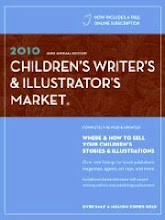Laurent Linn & Mark McVeigh: Graphic Novels 101...
On Monday at the SCBWI conference Henry Holt Associate Art Director Laurent Linn and Aladdin Editorial Director Mark McVeigh (formerly editor at Dutton) offered a short history of the graphic novel, starting with comic book deity Will Eisner's The Contract with God Trilogy in the late 70s (which is classified as the very first graphic novel), and moving through the popularity of manga today. They told us that in 2006 graphic novel sales in the U.S. and Canada hit $330 million, a 12% increase from the 2005 figures. Four million graphic novels have been sold through Scholastic Book Fairs since 2004. For young readers, picture books are the first fine art kids are exposed to--graphic novels serve that same purpose, they said. However, graphic novels can be much longer than picture books. There are a huge range of art styles and subject matter that can be appear in graphic novels. And both teachers and librarians seem to like them.
They told us that in 2006 graphic novel sales in the U.S. and Canada hit $330 million, a 12% increase from the 2005 figures. Four million graphic novels have been sold through Scholastic Book Fairs since 2004. For young readers, picture books are the first fine art kids are exposed to--graphic novels serve that same purpose, they said. However, graphic novels can be much longer than picture books. There are a huge range of art styles and subject matter that can be appear in graphic novels. And both teachers and librarians seem to like them.
They talked about the process for three different graphic novels and offered visuals for the projects in progression. Laurent discussed Blindspot, by Kevin C. Pyle, a graphic novel for which the same person created both the text and the art.
Laurent also talked a graphic novel written by one person and illustrated by another called Joey Fly, Private Eye, book 1: Creepy Crawly Crime (scheduled form Spring 08). For this project, he said, the author Aaron Reynolds wrote the dialogue in a screenplay format. Brian M. Weaver is the illustrator. Laurent described the creation as an organic process of text and illustration. The words begin the process and the art follows. Writers need to be flexible, revise, and collaborate. Mark McVeigh recounted his experience working on Dutton title called Dead High Yearbook, a graphic novel including a collection of creepy stories bound in a yearbook-type of format. (He wrote one of the stories for the collection.) Mark emphasized the importance of the "show, don't tell" rule when it comes to graphic novel writing, which he said is a highly structured form of writing. Writers must be open to text being cut to allow art to tell the story.
Mark McVeigh recounted his experience working on Dutton title called Dead High Yearbook, a graphic novel including a collection of creepy stories bound in a yearbook-type of format. (He wrote one of the stories for the collection.) Mark emphasized the importance of the "show, don't tell" rule when it comes to graphic novel writing, which he said is a highly structured form of writing. Writers must be open to text being cut to allow art to tell the story.
Someone (who had just attended Comicon) asked about the submission process for writers. Laurent and Mark agreed that writers would never submit rough sketches. Writers should instead submit a full manuscript (which I've gathered should be in a script format) and publishers then select an illustrator just as they do with picture books.
Monday, August 13, 2007
Subscribe to:
Post Comments (Atom)







No comments:
Post a Comment